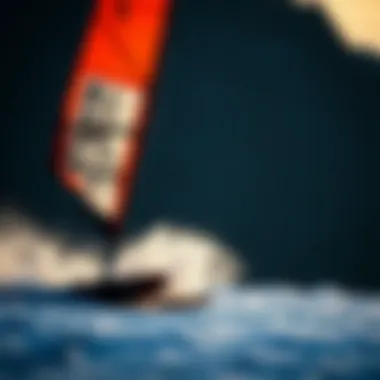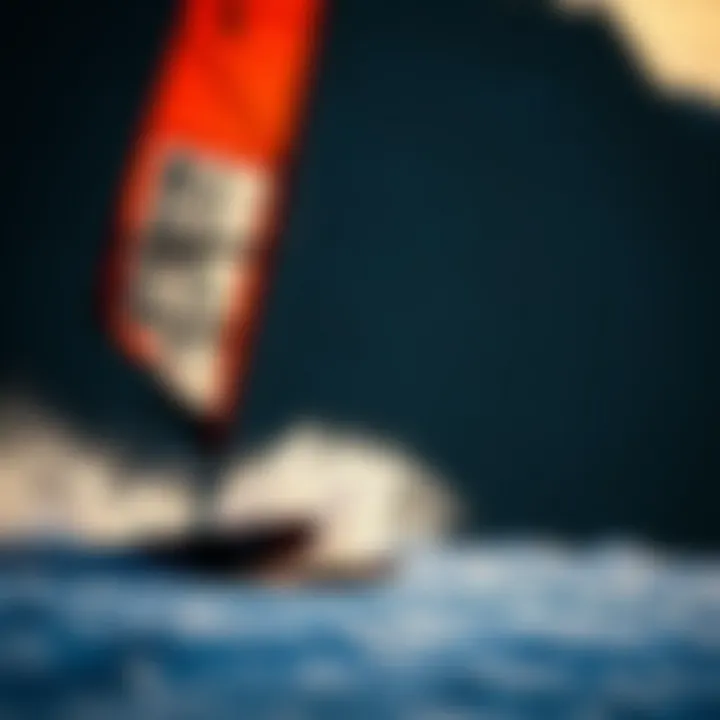Impact of Efoil Weight on Performance and Experience


Intro
In the realm of efoiling, where the thrill meets innovation, the weight of your efoil plays a critical role that can tip the scales between a fantastic ride and a frustrating one. This weight influences how well the board responds to your inputs, the overall stability while carving through waves, and even how efficiently it glides over the water.
Understanding the impact of efoil weight is not just for the racing enthusiasts but for everyone looking to enhance their ride experience. Whether you’re a seasoned veteran or just dipping your toes into this electrifying sport, the relationship between weight and performance can significantly shape the adventures you have on the water. Heavy boards might offer stability but can hinder speed; lighter boards can dance across the water but may feel less stable in challenging conditions.
Through this exploration, we'll examine essential aspects like design choices, material types, and rider skill levels—all factors intertwined with how weight affects your senses as you cruise along. No stone will be left unturned in painting a vivid picture of how these variables work together to define your efoiling experience.
Let’s dive into the nitty-gritty and explore how selecting the appropriate efoil weight can turn a good day on the water into a great one.
Understanding Efoils
In the realm of water sports, efoils have carved out a significant niche. This article dives into the essential components and mechanics of these intriguing craft. Understanding efoils is critical for both novice and experienced riders as it lays the groundwork for appreciating how various factors—particularly weight—impact performance and riding experience.
By comprehensively exploring what makes efoils tick, riders can better navigate the decision-making process involved in selecting the right gear. It’s not merely about choosing a board or a motor; it’s about harmonizing your preferences with technical specifications to achieve a smooth ride that aligns with your individual goals, be it leisurely gliding or competitive racing.
In the following sections, we will break down the mechanics and specific components of efoils. This will not only bolster your understanding of their operation but also significantly inform how weight plays a pivotal role in performance outcomes and overall enjoyment.
Mechanics of Efoiling
Efoiling is essentially a dance between physics and the design of the craft. At its core, an efoil comprises a hydrofoil—essentially a wing designed to lift the craft out of the water once sufficient speed is achieved. The fundamental mechanics involve thrust generated by an electric motor, which propels the board forward. As the board speeds up, the hydrofoil creates lift, raising the board above the water surface. This reduces drag, allowing for faster speeds while using less energy.
But mechanical efficiency doesn’t come solely from the design; the rider’s weight, technique, and environmental conditions also affect how effectively an efoil performs. A heavier rider might experience different performance dynamics compared to a lighter one, contributing to varied experiences on the same equipment.
Components of Efoils
Efoils aren’t just one entity; they’re a collage of multiple components, each playing a vital role in how the craft rides. Understanding these components helps riders grasp the full picture of their performance and experience.
Foil
The foil is arguably the heart of the efoil. Its primary function is to generate lift at speed, allowing the board to rise above the water. A well-engineered foil can significantly enhance ride efficiency and agility. Foils typically come in different shapes and sizes, with variations catering to different riding styles.
One key characteristic of a foil is its aspect ratio; a higher ratio yields better speed but might complicate stability for beginners. Conversely, a lower aspect ratio can offer improved control at the sacrifice of outright speed. Some riders gravitate towards wider foils for better stability, particularly those who are new to the efoiling scene.
Moreover, the build material of the foil—whether aluminum, carbon fiber, or a composite—affects not just the weight but also the responsiveness and durability of the equipment. Hence, choosing the right foil can make a world of difference in your efoiling adventure.
Board
The board serves as the foundation for the entire setup. Its length, width, and overall weight have substantial impacts on maneuverability and ride comfort. For instance, a longer board typically offers more stability, whereas shorter boards provide increased agility, attracting those who seek dynamic movements.
A noteworthy aspect of efoil boards is their buoyancy, which is crucial in how quickly novices can stand up after takeoff. The construction material, often foam or composite materials, can influence the overall weight, making it easier or harder to achieve that all-important lift during rides.
As with the foil, the weight of the board plays a direct role in the riding experience. Heavier boards may feel sluggish to some, while those who prefer stability might find them reassuring. The balance between weight and board length is imperative for riders to find their footing in this sporty arena.
Motor and Battery
The motor and battery are the engines behind the efoil's performance. They determine how quickly the board accelerates and how far it can go on a single charge. Electric propulsion systems bring in a level of convenience and ease, allowing for cleaner rides free from the noise and fumes associated with traditional gas-powered equipment.
The motor’s power output is typically measured in watts, and it’s a pivotal factor in influencing the board's top speed. Riders looking for speed will want to consider a high-wattage motor, while those prioritizing range might find a more modest power output sufficient.


Additionally, battery weight can significantly affect the overall performance of the efoil. A heavier battery may provide longer ride times but could negatively impact speed and agility. Grocery lists of considerations must weigh in—pun intended—when selecting the perfect motor and battery for one’s unique efoiling pursuits.
Efoil Weight – An Overview
Efoil weight plays a pivotal role in shaping the overall performance and experience of efoiling. Understanding this topic is crucial for riders to make informed decisions tailored to their unique needs and preferences. The relationship between weight and efficiency is not merely academic; it profoundly affects how the board behaves in water. A lighter efoil often allows for greater maneuverability, offering riders an exhilarating sense of freedom on the waves, whereas heavier models can contribute to stability and a steadier ride at higher speeds.
When delving into the particulars of efoil weight, we must consider several factors, including the materials used, the design of the board, and how these elements come together to affect performance. Furthermore, different weight ranges may cater to a variety of skill levels and riding styles, making this understanding essential for optimizing the efoiling experience.
First, we’ll unpack what exactly constitutes efoil weight. From the physical components to the added accessories, it's clear there's more than meets the eye when it comes to weight. Then we'll look at the typical weight ranges you might encounter in the market and what implications these weights have for performance on the water.
What Constitutes Efoil Weight?
Efoil weight encompasses all aspects of the equipment that affects its mass. This includes various components such as:
- Foil: The submerged part that lifts the board above the water, which can vary in size and material, contributing significantly to total weight.
- Board: The main body of the efoil, usually made from different materials that can either lighten or add bulk.
- Motor and Battery: These two components typically account for a large part of the efoil's total weight. The choice between a powerful motor for better speed or a lighter battery for easier handling can make a sizeable difference in overall performance.
- Accessories: Things like straps, fins, and additional features also play a role in weight.
It's crucial to analyze how these elements interplay. A carefully balanced efoil can lead to better handling and rider satisfaction. The right weight can enhance the overall experience, allowing riders to maneuver with greater ease and confidence.
Typical Weight Ranges
Efoils can vary widely in weight, typically ranging from 40 to 90 pounds. This diversity allows riders to choose according to their personal preferences and skill levels. Here’s a quick breakdown of typical weight ranges:
- Lightweight Efoils (40-55 lbs): Ideal for advanced riders looking for agility and speed. These options excel in quick turns and jumps, making them preferred choices for those who want to perform tricks or ride at high speeds.
- Mid-weight Efoils (55-70 lbs): Often a good balance for both beginner and intermediate riders. They provide stability and enough maneuverability to navigate tricky waters without feeling cumbersome.
- Heavier Efoils (70-90 lbs): Generally more stable and significant for beginners who may benefit from the extra support. While they may not be as quick on their feet, these boards can offer a reliable experience for those just learning the sport.
Material Composition and Its Effects
The way an efoil is constructed greatly influences its performance and rider experience on the water. Various materials used in efoil construction contribute directly to the overall weight, durability, and ride quality, making understanding these materials essential for any rider looking to optimize their experience. The choice of materials affects not just the efoil’s weight but also its response during use, with some materials being more suited for specific conditions and skill levels.
Common Materials Used
Fiberglass
Fiberglass is a well-known favorite in the efoiling community. Its main characteristic is a good balance between strength and weight. It’s often seen as a cost-effective choice for beginners and recreational riders. What sets fiberglass apart is its ability to absorb shocks; this means less jarring during rough rides.
The benefit of fiberglass lies in its resilience. While it may not be the lightest option available, its durability comes in handy when navigating choppy waters or enduring the occasional bump. However, one downside is its overall flexibility, which can sometimes lead to a less direct feel in handling compared to stiffer materials.
Carbon Fiber
When it comes to responsiveness and performance, carbon fiber often steals the scene. Known for being lightweight yet exceptionally strong, carbon fiber is preferred by advanced riders who seek efficiency. This material not only reduces drag but enhances speed, making it a popular choice for competitive racing.
One distinct feature of carbon fiber is its rigidity. This characteristic gives riders a more connected feel to the board, translating movements into quicker responses on the water. It’s also resistant to warping, making it an investment for those looking to advance their efoiling skills. However, the price tag is a factor to consider, as carbon fiber tends to come with a heftier cost than alternatives like fiberglass.
Plastic
Plastic, while often seen as the budget option, has compelling advantages of its own. It’s lightweight, making it easier for everyone, especially beginners. Riders new to efoiling may find plastic boards more manageable as they are generally easier to handle and provide a forgiving ride.
One unique feature of plastic is the ability to produce efoils at a lower manufacturing cost, making them accessible to a wider range of enthusiasts. However, its durability may not hold up compared to fiberglass or carbon fiber; over time, plastic can warp or become brittle, especially when exposed to the sun’s UV rays.
How Material Affects Weight


The weight of the efoil is directly tied to the materials chosen for its construction. Heavier materials generally yield a more stable ride, but they can dampen speed and agility. In contrast, lighter materials facilitate easier maneuvering but may sacrifice some stability. This trade-off is crucial in selecting an efoil that matches a rider’s ability and intended use. Weight considerations not only influence ride quality but also affect how riders interact with their surroundings on the water. A lighter board means a more dynamic ride, while a heavier board can offer comfort in rough conditions.
In summary, understanding the materials used in efoil construction—such as fiberglass, carbon fiber, and plastic—provides significant insight into how weight impacts ride experience. Each material brings its own set of characteristics that inform performance, giving riders the necessary knowledge to select an efoil that suits their personal needs. For more information on the impact of materials in sport and recreation, refer to Wikipedia.
Weight and Performance Correlation
Understanding the relationship between efoil weight and performance is crucial for anyone looking to enhance their riding experience. Weight plays a fundamental role in how an efoil interacts with the water, affecting various aspects like speed, agility, and stability. Essentially, a well-balanced efoil can mean the difference between slicing through the waves smoothly or slogging through a struggle.
Impact on Speed and Maneuverability
Efoil performance hinges significantly on its weight. When an efoil is on the lighter side, it can accelerate faster and change direction more easily. This nimbleness often translates to a quicker response to rider inputs, allowing for sharper turns and a more dynamic ride. Conversely, heavier efoils may provide a steadier ride, but they generally lack the agility that a lighter efoil offers.
For instance, an untrained eye may notice a lightweight efoil zipping beyond a heavier counterpart, especially in wake or wave conditions. A rider who prioritizes speed and agility might lean toward a lighter efoil design, while those who seek out a more stable and steady ride might prefer additional weight that adds to the overall feeling of security on the water.
Effect on Stability
While speed and maneuverability are key aspects, stability is just as critical in the overall performance of an efoil. A heavier efoil can offer increased stability, preventing excessive bouncing or jarring movements when hitting rough waters. This attribute can be particularly advantageous in choppy conditions, where maintaining control is paramount for an enjoyable ride.
On the other hand, ultra-lightweight designs can wobble or feel skittish at high speeds, making them less suited for beginners or those uncomfortable with unpredictable waves. Overall, the balance between weight and stability leads riders to make informed decisions based on both their skill level and riding conditions.
Rider Experience Considerations
Beginner vs. Advanced Riders
When considering efoil weight, it’s essential to factor in the skill level of the rider.
- Beginners: Often gravitate toward heavier boards for their stability. The extra weight can act as a safety net, providing a grounded feeling through the water. Beginners can focus on building their skills without the worry of excessive bouncing or instability. However, the trade-off can be a slower learning curve regarding agility and speed.
- Advanced Riders: Typically, these individuals favor lighter efoils, as they demand increased responsiveness and speed. Masters of their craft might crave the thrill that comes with quicker turns and swifter accelerations, which lighter efoils provide. Yet, advanced riders must balance these elements with the stability that may lessen when using a very lightweight board.
Personal Preferences
When choosing an efoil, personal preferences can't be overstated. Each rider has unique tastes shaped by goals and riding styles.
- Key Characteristics: Riders may prefer lightweight models for freestyle maneuvers or heavier options for long-distance cruising.
- Advantages and Disadvantages: Lightweight boards enhance performance in speed and maneuverability but may lack stability. Heavier boards provide a steadier experience but sacrifice some agility.
Ultimately, understanding one’s own riding preferences and how they correspond to efoil weight creates a pathway toward selecting the optimal board for each individual's journey on the water.
"The perfect efoil for you is the one that fits your style, skill level, and riding conditions best. There’s no single definition of 'right' in this endeavor."
Choosing the Right Efoil Weight
Choosing the right efoil weight is critical for enhancing the overall ride experience and performance. The weight of an efoil can significantly shape how it handles in the water, affecting factors like stability, speed, and maneuverability. Opting for the correct weight ensures that riders, whether beginners or seasoned pros, can effectively harness the efoil’s capabilities, meeting both their skill levels and riding goals. Finding that sweet spot, through the right balance of weight and design, is essential for enjoying every moment out on the water.
Factors to Consider
Rider's Weight
Rider's weight plays a vital role in determining the suitable efoil weight. Heavier riders usually require a more robustly designed efoil to ensure sufficient buoyancy and performance. A key characteristic of rider's weight is its direct impact on how well an efoil can lift off the water, which is necessary for a smooth ride.
- Benefits: A well-matched efoil weight can improve stability. This results in a more enjoyable experience as riders can navigate effortlessly without constantly battling the board's responsiveness.
- Considerations: However, a less experienced rider may not need as much power, making lighter options more advantageous. Balancing the rider's weight with the efoil's relative weight is crucial for optimal performance.


Experience Level
The experience level of the rider is another critical factor when selecting an efoil. Beginners often do better with a heavier efoil since it can provide increased stability. That extra weight means they are less prone to losing control easily.
- Benefits: An efoil suitable for beginners can equip them with the confidence needed to start learning the ropes of efoiling. Also, experienced riders may prefer lightweight models for agility and speedy turns.
- Considerations: Yet, lighter boards require skilled handling, and an overly ambitious beginner may see this as a disadvantage. Hence, it’s crucial to strike the right balance to maximize enjoyment on the water.
Intended Use
Lastly, intended use is a defining factor in making the right choice regarding efoil weight. Do you want to cruise leisurely or are you aiming for more aggressive sailing, tricks and stunts? This can hugely influence which weight suits your needs.
- Benefits: Stronger efoils, typically heavier ones, are essential for those looking to perform gliding maneuvers or surf across waves. They tend to be more stable and provide a comfortable ride under various conditions.
- Considerations: Conversely, for more leisurely rides or flat-water sessions, lighter efoils that allow for easier handling could be the way to go. Understanding your riding goals will guide you in making the best choice.
Recommendations for Beginners
If you're just starting out in the world of efoiling, choosing your board with care is crucial. Here are some tips to help beginners select the right efoil weight:
- Opt for Stability: A heavier efoil provides more stability, which can be greatly helpful when learning to control balance on the water.
- Prioritize Comfort Over Speed: Initially, a more stable board will allow you to focus on getting the hang of it, rather than chasing speed right away. Over time, as you become comfortable, you can start experimenting with lighter setups.
- Consult Experts: Don’t hesitate to seek advice from local shops or forums. Experienced riders often share invaluable insights that can help you make educated decisions.
Trends in Efoil Weight Technology
The evolution of efoil technology has led to significant transformations in terms of weight management, which plays a critical role in performance. As riders seek to maximize their experience on the water, manufacturers have started to delve deeper into creating lighter and more efficient efoils. Understanding the trends in efoil weight technology is not just an academic exercise; it directly influences ride capabilities, aerodynamics, and even rider fatigue. It affects everything from the maximum speed a rider can achieve, to how responsive the board is during turns.
Innovative Designs
Recent innovations in efoil design focus on reducing weight without sacrificing durability. Companies like Lift Foils and Fliteboard have introduced new geometries that optimize both buoyancy and drag. By tweaking the foil shape and board dimensions, engineers can create a profound impact on overall performance. For instance, a well-designed efoil with a smaller surface area can significantly enhance speed while ensuring stability.
Moreover, advancements in 3D printing technology have opened doors for prototyping intricate designs that were previously thought impractical. Some brands are experimenting with modular designs, allowing riders to customize their efoils based on their skill levels and riding styles. This clay-like flexibility in design not only makes the efoils lighter but also caters to personalized performance.
"The lighter the efoil, the more control and efficiency a rider can expect while gliding over water."
Future Directions in Material Science
Looking ahead, material science will play a pivotal role in defining the next generation of efoils. Trends in composite materials, particularly the development of advanced polymers and hybrid composites, are on the rise. These materials are not only lighter but also offer higher tensile strength than traditional fiberglass.
- Carbon Fiber Reinforcements: More manufacturers are integrating carbon fiber into their efoils. This material allows for a lightweight structure that remains rigid, contributing positively to speed and maneuverability.
- Nanotechnology: Emerging nanomaterials could revolutionize the manufacturing processes in the efoiling industry. By embedding nanoparticles within existing materials, manufacturers can improve strength to weight ratios, creating efoils that are both lightweight and robust.
With an eye toward sustainability, some companies are exploring eco-friendly materials that can withstand water exposure while reducing the overall environmental footprint.
The End
The topic of efoil weight holds significant importance in the realm of water sports, particularly in shaping the overall experience for riders. Understanding how weight influences performance is crucial for both novice and seasoned enthusiasts alike.
Summary of Key Points
The various elements discussed throughout the article shed light on the nuanced relationship between efoil weight and functionalities such as speed, maneuverability, and stability. Here are the essential takeaways:
- Weight Definition: Efoil weight isn't simply about how much the equipment weighs; it encapsulates the interplay of materials and design.
- Performance Impact: As explored, lighter efoils generally offer better speed and agility, while heavier options might provide stability but at a cost to maneuverability.
- Material Composition: Different materials used in construction play a pivotal role in determining weight and corresponding performance attributes. For example, carbon fiber is lighter and stronger compared to traditional fiberglass.
- Rider Dynamics: Personal attributes such as rider weight and skill level significantly contribute to how an efoil's weight plays out in practical scenarios. Beginner riders may appreciate the stability a heavier board provides, while advanced riders might thrive on the performance of a lighter model.
Final Thoughts on Efoil Weight
In summary, the discussion surrounding efoil weight transcends mere numbers on a scale. It encompasses an intricate dance between design, material science, and rider dynamics. When selecting an efoil, one must consider not just the weight itself but how that weight interacts with personal goals and riding conditions. This holistic approach enables riders to better tailor their experience, ultimately enhancing performance on the water.
"Bigger ain’t always better, especially when it comes to efoils; finding the sweet spot is where the magic happens."
As technology continues to advance in material science and design, the lightening of efoils is poised to enhance user experiences further. The future directions in this field may very well promise even more exhilarating adventures on the waves. For those looking to maximize their time on the water, it's wise to pay close attention to how weight factors into their efoil choice. Understanding these intricacies can pave the way for a more enjoyable and efficient riding experience.















